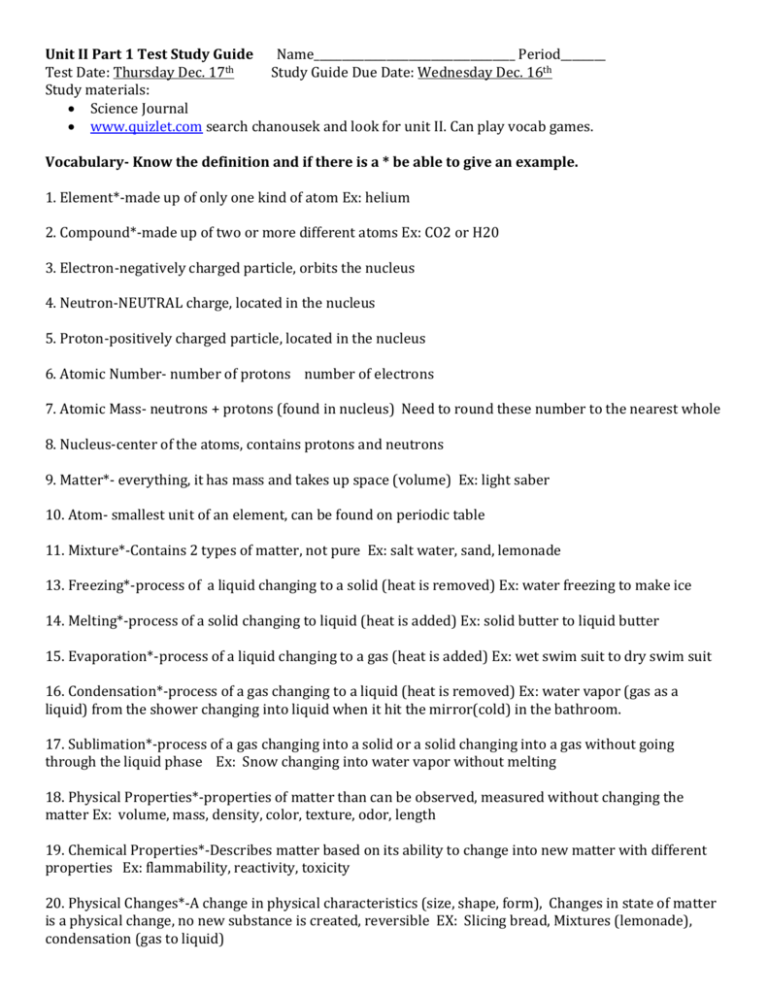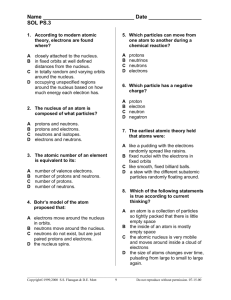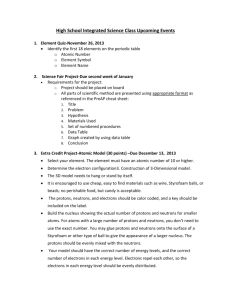Concepts Journal Pages Notes
advertisement

Unit II Part 1 Test Study Guide Name____________________________________ Period________ th Test Date: Thursday Dec. 17 Study Guide Due Date: Wednesday Dec. 16th Study materials: Science Journal www.quizlet.com search chanousek and look for unit II. Can play vocab games. Vocabulary- Know the definition and if there is a * be able to give an example. 1. Element*-made up of only one kind of atom Ex: helium 2. Compound*-made up of two or more different atoms Ex: CO2 or H20 3. Electron-negatively charged particle, orbits the nucleus 4. Neutron-NEUTRAL charge, located in the nucleus 5. Proton-positively charged particle, located in the nucleus 6. Atomic Number- number of protons number of electrons 7. Atomic Mass- neutrons + protons (found in nucleus) Need to round these number to the nearest whole 8. Nucleus-center of the atoms, contains protons and neutrons 9. Matter*- everything, it has mass and takes up space (volume) Ex: light saber 10. Atom- smallest unit of an element, can be found on periodic table 11. Mixture*-Contains 2 types of matter, not pure Ex: salt water, sand, lemonade 13. Freezing*-process of a liquid changing to a solid (heat is removed) Ex: water freezing to make ice 14. Melting*-process of a solid changing to liquid (heat is added) Ex: solid butter to liquid butter 15. Evaporation*-process of a liquid changing to a gas (heat is added) Ex: wet swim suit to dry swim suit 16. Condensation*-process of a gas changing to a liquid (heat is removed) Ex: water vapor (gas as a liquid) from the shower changing into liquid when it hit the mirror(cold) in the bathroom. 17. Sublimation*-process of a gas changing into a solid or a solid changing into a gas without going through the liquid phase Ex: Snow changing into water vapor without melting 18. Physical Properties*-properties of matter than can be observed, measured without changing the matter Ex: volume, mass, density, color, texture, odor, length 19. Chemical Properties*-Describes matter based on its ability to change into new matter with different properties Ex: flammability, reactivity, toxicity 20. Physical Changes*-A change in physical characteristics (size, shape, form), Changes in state of matter is a physical change, no new substance is created, reversible EX: Slicing bread, Mixtures (lemonade), condensation (gas to liquid) 21. Chemical Change*-A change where a new substance is formed, cannot be reversed. Hints: change in color, new odor, sound produced, heat given off, smoke, light EX: Rust, fireworks, burning log Concepts 1. Be able to accurately calculate the number of protons, neutrons and electrons. Be able to label the electrons, protons, neutrons and their charges. Journal Pages Notes 41,44,45,47 2. Know the difference between an element and compound. Be able to give examples for each. p. 55, 58,59 3. Be able to describe the attraction, movement, volume and shape. 68 4. Be able to explain how heat (adding & removing) affects solids, liquids and gases. 72,73, Boron’s atomic number is 5. This means that it has 5 protons (+) located in the nucleus and 5 electrons (-) located in the shells surrounding the nucleus. To calculate the neutrons (neutral) the atomic mass of 10.8 would round to 11 and 11-protons (5)= 6 neutrons. Neutrons + Protons=atomic mass Elements are made of only one kind of atom, but it can have more than one of that atom. EX: H2 is an element even though there are 2 hydrogens. Compounds are made up two or more different kinds of atoms. EX: water (H2), carbon dioxide (CO2) Solid-strong attraction, vibrating movement, definite shape and volume Liquid-somewhat attracted, slide past each other in movement, definite volume, no definite shape-takes the shape of container Gas-weak attraction, zooms quickly in movement, no definite shape and no definite volume Solids, Liquids and Gases when heat is added the space between the molecules expands and the molecules/ particles move faster. Solids, Liquids and Gasses when heat is removed the space between the molecules contracts and the molecules/particles slow down a bit. 5. Be able to calculate volume using LXWXH and water displacement method. Be able to label your answers with correct units. 76 6. Be able to identify chemical and physical changes from an image. Be able to list 2 reasons that support your answer. 60-66 7. Be able to identify variables (independent, dependent, constants) when given a scientific method experiment. Unit I p. 18, 19, 25 Regular shapes V=LXWXH Answers will have the units cm3 Irregular shapes (water displacement)Measure volume of water in graduated cylinder, place object in cylinder and measure new water level. Subtract new water level from first water level to calculate the volume of the object. Answers will have units ml (milliliter) Bread Toasting=chemical change, new color, new odor Ice melting=physical change, all changes in states of matter (solid to liquid) are physical changes, no new substance, reversible Independent variable is the thing that is changed in the experiment (X) Dependent variable is the thing that we measure in the experiment (Y) The constants are the things that are kept the same to ensure that only the independent variable is being tested. Constants are need to make sure that the experiment is “FAIR”










